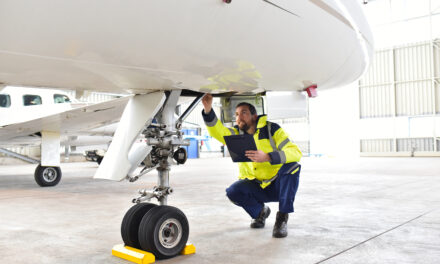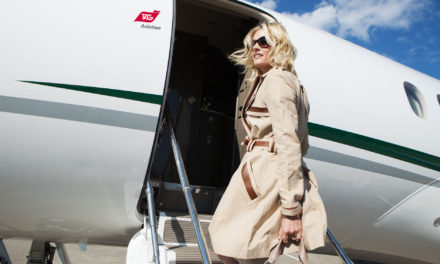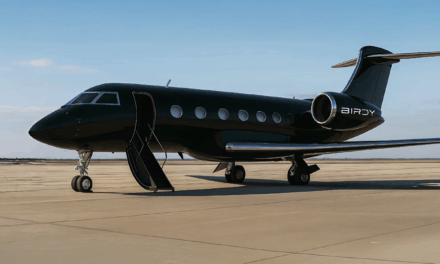The fields of sugarcane soak up the hot Brazilian sun in the month of March and soak in the summer rain storms to produce high quantities of sugar in the Araraquara region. On the outskirts of the Gavião Peixoto airfield awaits the Legacy 450, Embraer’s latest business jet that we are taking out for a flight.
Gavião Peixoto is a private airfield located far from the hustle and bustle of general aviation. To say that I have enjoyed visiting this site on more than one occasion would be an understatement. The airfield has one of the largest/longest active runways in South America (4,967 m). This location was also used for the space shuttle program when it was still operating. The private runway is part of the vast airfield owned by Embraer since 2001, and which has undergone continuous upgrades. The manufacturer set up its military sector here for the assembly of the Super Tucanos and for modernization work on certain aircraft such as the Força Aérea Brasileira (BAF – Brazilian Air Force) including the Northrop F-5 or the Douglas A-4D Skyhawk of the Brazilian Naval Aviation Force (Aviação Naval Brasileira). However, the Gavião Peixoto site is not solely dedicated to military aircraft. It is also where the final assembly of Phenom 100 and 300 takes place and where tests flights are performed for aircraft off the assembly line and for ongoing programs such as the E-Jet E2, theKC-390 and of course the Legacy 450 which recently obtained certification from the Brazilian authorities and the FAA.
WHY THE LEGACY 450?
It is in the vicinity of the magnificent Hawker Hunter used for high-speed escort missions and at a fair distance from the KC-390 that I met my two pilots for the day’s flight: Captains Berto and Salgado, Embraer factory pilots. After having met the crew, we began our briefing on the origin of the 450, its performance and its systems. But one question remains: why develop the Legacy 450 considering the success of the Legacy 500 program? For the Brazilian aircraft manufacturer, the answer lies in customer demand and the logical development of its business jet catalog. Truth be told, the family was lacking a mid-light aircraft to meet the need for greater flight range as well as advances in technology and outstanding comfort for this segment. At the same time, the Legacy 450, like the 500, benefited from development in a period where customer feedback focused on the needs of lower capacity for these segments while seeking optimized costs. While listening to the market, the common features between the two aircraft enabled Embraer to optimize costs across all levels as well as the performance of the two machines. And to say the least the results have lived up to customer expectations.
VISIT… PRE-FLIGHT
After the morning briefing, we take a tour of both the inside and outside of the jet. This phase allows me to get familiar and take a closer look at the differences between the 450 and its predecessor the 500 that we tested in Ultimate Jet number 44. Our Legacy 450, registered PR-LKN, is one of the demonstration aircraft belonging to Embraer used for the program’s cabin validation. It is therefore complete and in a deliverable state to a potential customer. From further away I thought it would be easy to differentiate between the two models, however the closer I get the more I realize how many common features they share. Only the number of windows differ which corresponds to just a portion of difference between the two jets airframes. For the rest, the Legacy 450 is a nearly identical copy to its predecessor and may easily be mistaken as the similarities are numerous: from the superb winglets, to the tailfin and its horizontal profile giving it a very robust appearance in addition to the exterior baggage hold with the same capacity (110 ft3). Access for refueling, as well as oxygen and hydraulic maintenance are also positioned identically on the two twinjets. Inside, the design and comfort are such to make you forget about the cabin length of the 500. And again, with the same cabin height in the central aisle of 1.83 m (6 ft), the lavatory at the rear separated from the cabin, the particularly refined quality of finishings, it is easy to confuse the 450 with its higher-end predecessor.
GETTING STARTED
The flight deck with its sleek and flawless design confirmed this feeling: it is like being in a very posh “super midsize”! Comfortably settled in the left-hand seat, I discuss with Captain Berto who gives me an overview on the ProLine Fusion avionics system on our flight deck. The ergonomics of the system with a large size flight deck, magnificently streamlined, with 15.1-inch multifunction LCD screen and side-sticks means that the pilot will very quickly feel at ease. The display choices like the additions concerning the flight plan as well as speed, weight and balance indicators and radio selections are simple and often intuitive. In under 15 minutes without any specific review on my behalf we were ready to get started. Just like the system, this too is simple. We are soon taxiing towards runway 20 and the nose wheel steering, specific to the rudder, only requires a subtle push from the engine and practically no braking. This brake by wire system, equipped with carbon brakes, is quite resilient to heat (the temperature can be checked from the flight deck). Its (extended) life span, its anti-skid protection and above all its automatic braking system are unprecedented for this aircraft segment. Its auto brake system provides optimal braking adaptation based on the weight/speed at landing in order to clear to the most suitable taxiway and offers increased landing safety conditions through the RTO (Rejected Take-Off) function. This function is used for optimal safety braking in the event of interrupted takeoff. Electronic checklists and the Surface Management System (SMS) are used to visualize the position of the aircraft based on global data from over 400 terrains. This allows the pilots to focus on the essential while taxiing which can get busy especially in complicated terrain and also improves flight safety. We are quickly authorized to line up and for takeoff with the following particularity: located at the 2/3 mark of runway 20 is a “pool” (a rectangle formed by plastic tubing filled with water that is several centimeters high). It is extended by a 1,500 m strip for trials of the E-Jet E2 and we are going to have to avoid it. With a width of over 50 m, this should not be a problem. From the power-up (at 80% on brakes), I can feel that the Honeywell HTF7500E engines will quickly lift us into the air. The acceleration for this take-off in TOGA (Take Off Go Around) is sudden, especially with our current weight of 30,000 lbs (a little over 15t), with two “passengers”, two pilots and 6,500 lbs (2,950 kg) of fuel. The 6,500 lbs of single thrust from the engines can be felt despite the temperate of 31°C, we are airborne and reaching 35 ft in less than 900 m. It is easy to believe the performance optimization of the engines in a hot and humid environment. We do not lose any time retracting the flaps and with authorization from control we continue to rise to the jet’s practical ceiling, i.e. Flight Level 450 (45,000 ft – 13,716 m). Initially at an indicated air speed of 320 Kt, we are close to a 5,000 feet per minute climb rate up to FL 150. Between FL 200 and 340 our indicated air speed decreases to 280 Kt and finally at Mach 0.68 our vertical speed tapers to 3,400 then 2,000 ft per minute and stabilizes at around 1,300 ft/minute between levels FL 380 and FL 450.
The entire climb, from the retraction of the landing gear, took 22 minutes to reach the aircraft’s flight ceiling. This results in an average vertical speed of over 2,000 ft/minute and a consumption of 2,500 lbs. At FL450, the auto-pilot controls the half banks, i.e. at less than a 15° bank angle. Initially at Mach 0.74, I increase power to the max continuous power setting in order to accelerate to the maximum cruising Mach i.e. 0.80 that we reach in a few minutes with 88% of power and a fuel flow of 1,300 lbs (a little less than 6,000 liters/hour). I perform a cruise check of the circuits using the synoptics that I display on our central screen. Our cabin pressure at FL 450 (45,000 ft) is 6,000 ft (1,828 m) or a delta of 9.6 PSI, which is greatly appreciated for physiological comfort during long flights.
IN THE CABIN
I hand over control of the jet for a few minutes to my pilot and head back to the cabin to check out the conditions at high speed. The noise level is surprisingly low even close to the engines at the rear of the cabin. I tested the club seats which in addition to their impeccable finishing are extremely comfortable. They can also be transformed into two fully flat beds in minutes which optimize comfort during night flights. Attention to detail can be seen throughout: from the cup holders to the upper panel of the cabin system controls. This system provides simple and direct management of the cabin lighting and temperature and also displays the remaining flight time. The side compartments, which contains elegant folding tables as well as on-board remote controls to access all available functions and make phone calls based on the selected communication options (SatCom, Inmarsat, etc.), are particularly well designed. The large windows are cleverly placed in order to disperse light and provide passengers with an optimized field of vision. The rear lavatory, very elegantly separated from the cabin by a sliding partitioned door, offers a large sink and classic toilet (with a flushing tank and water refill system) that features a seat which is certified for use during takeoff and landing. Access to the interior baggage hold is also found in the rear with 35 ft3 or 0.99m3 of storage space. There is an abundant feeling of comfort and space throughout the cabin reflecting a level of design quality usually found in higher-segment aircraft.
TESTED STABILITY
Back on the flight deck, we descend to FL180 in direct descent mode without constraint (Flight Level Change) setting our rate of descent to 3,000 ft/min. I increase the rate to 8,000 ft/min using the airbrake function of the upper spoilers. I then gleefully follow with banks at 30, 45° and 60°. The maneuverability and roll rate are good and the handling remain precise using the side-sticks thanks to the fly-by-wire system. That’s right! The Legacy 450 is the first jet of its kind to offer FBW, which until recently could only be found on higher segment jets. We continue our handling tests checking the protections offered by this FBW system. First of all at high speed. I disconnect the auto-pilot and auto-throttle and try to accelerate above the red-line maximum speed in TOGA which is refused by the system. In the event of a sudden jolt on the side-stick in this configuration, the load factor protection limits me to 2.5 G. In low speeds, with the auto-throttle active, I am unable to reduce below VLS (the lowest selectable speed that can be viewed in our speed range by a yellow zone) +5 kt. Then by disconnecting the auto throttle and keeping the engines fully reduced, with a maximum pitch attitude action at the side stick, I cannot override in attitude the PLI (Pitch Level Indicator) displayed on our primary flight display and which materializes the maximum pitch getting us close to the critical incidence not to be exceeded. The active audio alert repeats: “Stall!”, “Stall!” whereas I fly with a maximum action on the sidestick. It is just impossible to “exceed” the PLI indicator and we descend to around 1,000 ft/min with a stable speed, slightly in the « yellow speed tape » and still with roll authority. I then perform the same test at low speed in landing configuration and the handling is the same throughout the exercise. Getting out of this stall approach by increasing power remains particularly an easy task. I then stabilize at altitude with 180 kt and 10° pitch and then advance the throttles all the way to TOGA (Take off go around) without autopilot nor hands on my side stick. Our Legacy 450 speeds up without any side effects caused by the increase in power. Likewise, in the same configuration, I increase the lever to full throttle and the aircraft remains stable on its path, slowing down to the previously seen limits.
I attempt some sudden movements in roll as well as accelerations and decelerations: the secondary effects such as inadvertent roll and yaw movements (e.g. dutch roll) can hardly be felt. Our fly-by-wire system offers a normal control law and a direct control law. In the event of a failure, this direct law with lesser protections than those previously verified, will still be active thus making it impossible to bring the aircraft in a stall or in an extreme load factor situation. In normal mode, the simple and effective system offers stability and flight comfort in all configurations and even more so in difficult conditions (turbulence, wind gusts, etc.).
RETURN FLIGHT
It is now time to make our way back to Gaviao and I switch back the auto-pilot in order to enter the RNAV approach for runway 02 into our Flight Management System (FMS). In minutes, this system with our planned landing weight will display our reference speed at the approach threshold. Just as a commercial aircraft, I activate our Lateral Navigation (LNAV) and Vertical Navigation (VNAV) modes before doing the descent checklist. Our Legacy follows a vertical path respecting the specifics of the standard arrival inserted and a lateral path following the Rnav fixes (radio-navigation points of reference). We perform the approach briefing with Captain Berto discussing the sequence and the key points of our Rnav procedure. The ATC asks us to hold our position at 3,500 ft before starting our final approach. At this time, my pilot demonstrates the ease and speed of intervention on the system in such a case. The aircraft instantly follows a standard holding pattern before being authorized to proceed after two racetracks. I then set the system to re-intercept the final part of approach and our 450 continues in automatic provided that the minima and the go-around altitude are inserted at the right time. Aligned on final for runway 02, I take back manual control of the aircraft. The short final, with little wind, could not be easier to handle up to the touch and go. And as soon as my pilot retracts the flaps in takeoff position, I resume the power setting back to TOGA and we are almost instantly airborne. We are off like a rocket up to 1,500 ft in a matter of seconds and I quickly reduce in order to maintain altitude and speed. The visual pattern is just a pleasure at the controls. The extended field of vision of the flight deck provides the pilots with excellent comfort. Once again we are on short final for this 5,000 m runway. Landed in less than 800 m with auto-brake at level 3 for a compromise between passenger comfort and braking effectiveness. We taxi and avoid the “pool” to clear the runway and return to Embraer’s parking facilities.
A RIVAL FOR HIGHER-PRICE SEGMENTS
As is often the case, I find myself shutting down the engines hoping that this flight would still go on. However all good things must come to an end. And yet good things are just beginning for the Legacy 450 and I firmly believe that it will revolutionize its aircraft segment (mid-light) by offering nearly everything of the mid-size but at a lower price. A Legacy 450 costs around $16.6M whereas a Legacy 500 is $20M. Based on a study performed by a private firm, the direct operating costs of the aircraft including fuel, provisions for engine, APU and airframe maintenance are announced to be under $2,400 per flight hour (thus $5.5 per nm flown). Such a reasonable cost given the performance of the aircraft!! At the same time, the aircraft’s warranty program (60 months or 3,000 flight hours for parts!) as well as the advanced parts commonality, the common type qualification between the Legacy 450 and 500 and the computerized maintenance system for the aircraft family enable Embraer to provide the market with an optimized offer particularly interesting considering the fierce competition in the sector.
In addition to this aspect, it is also interesting to note that customer support, an essential component for the purchase of this type of aircraft, is particularly important to Embraer. Over the years, the Brasilian aircraft maker has developed a large maintenance network throughout the world and has also received numerous awards on behalf of various professional associations for the quality of its service. A look at the tarmacs of the major business aviation sites around the world over the coming years will reveal whether the Legacy 450 is a winning bet… In the mean time and like its predecessor, the Legacy 450 has completely won me over.
By Greg Cellier
Copyright : EMBRAER / GREG CELLIER








